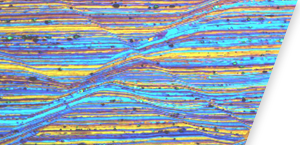1. Sidorov V.V., Kablov D.E., Rigin V.E. Metallurgy of casting heat-resistant alloys: technology and equipment. Ed. E.N. Kablov. Moscow: VIAM, 2016, 368 p.
2. Illarionov E.I., Kolobnev N.I., Gorbunov P.Z., Kablov E.N. Aluminum alloys in aerospace engineering. Ed. E.N. Kablov. Moscow: Nauka, 2001, 192 p.
3. Reshetnikov Yu.V., Trapeznikov A.V., Vlasova K.A., Leonov A.A. Different factors influence on technological properties of self-hardening phenol formaldehyde resin sands. Part 1. Aviation materials and technologies, 2024, no. 1 (74), paper no. 05. Available at: http://www.jornal.viam.ru. DOI: 10.18577/2713-0193-2024-0-1-63-77.
4. Guseva M.A., Sinyakov S.D., Dolgova E.V., Ponomarenko S.A. Study of the effect of the properties of phenol-formaldehyde resin and the curing mode on the characteristics of the FN binder. Aviation materials and technologies, 2022, no. 2 (67), paper no. 06. Available at: http://www.journal.viam.ru (accessed: August 11, 2023). DOI: 10.18577/2713-0193-2022-0-2-63-73.
5. Lewandowski J.L. Materials for foundry molds. Cracow: AKAPIT, 1997, 598 p.
6. Lessiter M.J., Kotzin E.L. Timeline of casting technology. Engineering Casting Solutions, 2002, vol. 4, pp. 76–80.
7. Pilato L.A. Phenolic resins: a century of progress. Springer New Jersey, 2010, 542 p. DOI: 10.1007/978-3-642-04714-5.
8. Tang K., Zhang A., Ge T. et al. Research progress on modification of phenolic resin. Chemistry, Materials Today Communications, 2020, vol. 26, pp. 34–70. DOI: 10.1016/j.mtcomm.2020.101879.
9. Huang R., Yanmin W., Zhang B. Curing mechanism of alkaline phenolic resin with organic ester. China Foundry, 2014, vol. 11, p. 447–451.
10. Nair C.P.R. Advances in additioncure phenolic resins. Progress in Polymer Science, 2004, vol. 29, pp. 401–498. DOI: 10.1016/j.progpolymsci.2004.01.004.
11. Zastrogina O.B., Sinyakov S.D., Serkova E.А. Materials based phenolformaldehyde oligomers of resol and novolac tipes (review). Part 1. Trudy VIAM, 2021, no. 10 (104), paper no. 06. Available at: http://www.viam-works.ru (accessed: September 01, 2023). DOI: 10.18577/2307-6046-2021-0-10-58-66.
12. Zastrogina O.B., Sinyakov S.D., Serkova E.А. Materials based on phenolformaldehyde oligomers of resol and novolac tipes (review). Part 2. Trudy VIAM, 2021, no. 11 (105), paper no. 06. Available at: http://www.viam-works.ru (accessed: September 01, 2023). DOI: 10.18577/2307-6046-2021-0-11-55-65.
13. Gardziella A., Pilato L.A., Knop A. Phenolic Resins: Chemistry, Applications, Standardization, Safety and Ecology. 2nd ed. Springer-Verlag Berlin Heidelberg, 2000, 584 p.
14. Holtzer M., Kmita А. Mold and Core Sands in Metalcasting: Chemistry and Ecology. Springer Nature Switzerland AG, 2020, 359 p. DOI: 10.1007/978-3-030-53210-9.
15. Prusenko I.N. Study of the strength properties of CTS. Research and development in the field of mechanical engineering, energy and management: Materials of the XIII Int. sc.-tech. conf. students, undergraduates and young scientists. Gomel: GGTU im. BY. Sukhoi, 2013, pp. 125–129.
16. Boenisch D., Lotz W. Causes for unexpected losses of strengths of cold box cores. Giesserei Praxis, 1985, vol. 72, p. 83–88.
17. Archibald J.J., Robinson M.L. Recycling amine catalysts: a pollution prevention tool. AFS Transactions, 1994, vol. 102, pp. 555–558.
18. Liu W., Li Y., Qu X., Liu X. Study on binder system of CO2 cured phenol – formaldehyde resin used in foundry. 68th World Foundry Congress, 2008, pp. 313–317.
19. Westwood G.W. The cast for heat-cured molding and coremaking processes. Foundry Trade Journal, 1985, vol. 158, pp. 512–516.
20. Wang J., Huang R., Qiu X. Research on reclamation synthesizing technique of used sand for ester-cured alkaline phenolic resin. Foundry, 2009, vol. 58, pp. 175–180.
21. Ji S., Wan L., Fan Z. The toxic compounds and leaching characteristics of spent foundry sands. Water, Air, & Soil Pollution, 2001, vol. 132, pp. 347–364.
22. Hankun L., Shicheng L., Xin Z. et al. Study on the ester-cured alkaline phenolic binder systems for large steel casting. Proceedings of the 69th World Foundry Congress, 2010, pp. 674–678.
23. Huang R., Zhang B., Tang Y. Application conditions for ester cured alkaline phenolic resin sand. China Foundry, 2016, vol. 13, pp. 231–237.
24. Fortini A., Merlin M., Raminella G. A comparative analysis on organic and inorganic core binders for a gravity diecasting Al alloy component. International Journal of Metalcasting, 2022, vol. 16, pp. 674–688. DOI: 10.1007/s40962-021-00628-1.
25. Song L., Liu W., Li Y., Xin F. Humidity-resistant inorganic binder for sand core making in foundry practice. China foundry, 2019, vol. 16, pp. 267–271. DOI: 10.1007/s41230-019-8169-8.
26. Anwar N., Sappinen T., Jalava K., Orkas J. Comparative experimental study of sand and binder for flowability and casting mold quality. Advanced Powder Technology, 2021, vol. 32, pp. 1902–1910. DOI: 10.1016/j.apt.2021.03.040.
27. Galante G., Mikilli O., Prospero R. Molding using CTS. Our view: in 2 parts. Italy: IMF Luino, 1997, рart 1, 161 p.
28. Khandewal H., Ravi B. Effect of molding parameters on chemically bonded sand mold properties. Journal of Manufacturing Processes, 2016, vol. 22, pp. 127–133.
29. Boldin A.N., Davydov N.I., Zhukovsky S.S. Foundry molding materials. Molding, core mixtures and coatings: a reference book. Moscow: Mashinostroyenie, 2006, 507 p.
30. Kukuy D.M., Skvortsov V.A., Andrianov N.V. Theory and technology of foundry production: textbook in 2 parts. Minsk: New knowledge; M.: INFRA-M, 2013. Part 1: Molding materials and mixtures, 384 p.
31. Schulze D. Flow properties of powders and bulk solids. Available at: www.researchgate.net/publications/267818207_Flow_Properties_of_Powders_a... (accessed: August 15, 2023).
32. Kidalov N.A., Osipova N.A., Potashova I.E., Rybalchenko K.O., Lysochenko V.V. Cold-hardening mixtures for the No-bake process. Liteynoe proizvodstvo, 2019, no. 3, pp. 99–102.
33. Zhukovsky S.S. Cold-hardening binders and mixtures for foundry cores and molds: a reference book. Moscow: Mashinostroyenie, 2010, 256 p.
34. LaFay V. Application of no-bake sodium silicate binder system. International Journal of Metalcasting, 2012, vol. 6, pp. 19–26.
35. Kidalov N.A., Osipova N.A., Potashova I.E., Rybalchenko K.O. The use of chromite sand in cold-hardening molding sands for the No-bake process. Liteynoe proizvodstvo, 2019, no. 11, pp. 483–487.
36. Foundry technology: molding and core mixtures: textbook for univ. Ed. S.S. Zhukovsky et al. Bryansk: BSTU Publ. House, 2002, 470 p.
37. Stauder B.J., Kerber H., Schumacher P. Foundry sand core property assessment by 3-point bending test evaluation. Journal of Materials Processing Technology, 2016, vol. 237, pp. 188–196. DOI: 10.1016/j.jmatprotec.2016.06.010.
38. Krause J., Davis W. 5 Tips to minimize amine use and reduce pollution. Mod Cast, 2011, vol. 101, pp. 36–39.
39. Czerwinski F., Mir M., Kasprzak W. Application of cores and binders in metalcasting. International Journal of Cast Metals Research, 2015, vol. 28, pp. 129–139. DOI: 10.1179/1743133614Y.0000000140.
40. Kmita A., Fischer C., Hodor K. et al. Thermal decomposition of foundry resins: a determination of organic products by thermogravimetry–gas chromatography–mass spectrometry (TG–GC–MS). Arabian Journal of Chemistry, 2018, vol. 11, pp. 380–387. DOI: 10.1016/j.arabjc.2016.11.003.
41. Glowacki S.M., Crandell C.R., Cannon G.R. et al. Emissions studies at a test foundry using an advanced oxidation-clear water system. AFS Transactions, 2003, vol. 111, pp. 579–598.
42. Wang Y., Cannon F.S., Salama M. et al. Characterization of hydrocarbon emissions from green sand foundry core binders by analytical pyrolysis. Environmental Science & Technology, 2007, vol. 41, pp. 7922–7927. DOI: 10.1021/es071657o.
43. Major-Gabrys K. Environmentally Friendly Foundry Molding and Core Sands. Journal of Materials Engineering and Performance, 2019, vol. 28, pp. 3905–3911. DOI: 10.1007/s11665-019-03947-x.
44. Fox J.T., Cannon F.S., Brown N.R. et al. Comparison of a new, green foundry binder with conventional foundry binders. International Journal of Adhesion & Adhesives, 2012, vol. 43, pp. 38–45. DOI: 10.1016/j.ijadhadh.2011.11.011.
45. Snelling D., Williams C., Druschitz A. A comparison of binder burnout and mechanical characteristics of printed and chemically bonded sand molds. Proceedings of the Solid Freeform Fabrication Symposium, 2014, pp. 197–209. DOI: 10.26153/tsw/15677.



